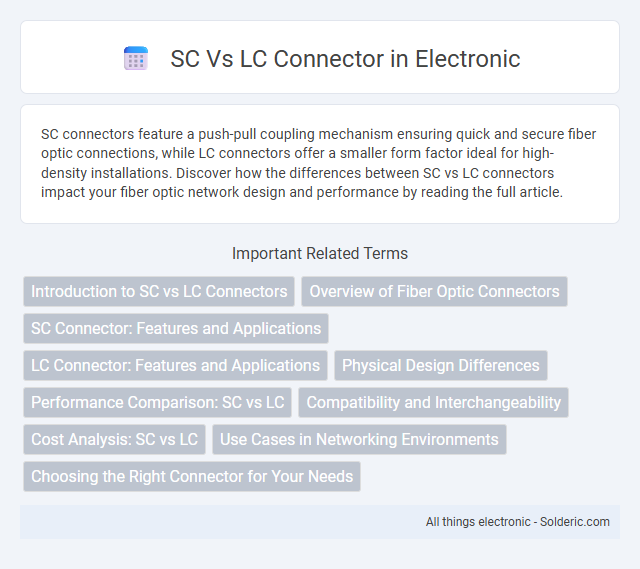SC connectors feature a push-pull coupling mechanism ensuring quick and secure fiber optic connections, while LC connectors offer a smaller form factor ideal for high-density installations. Discover how the differences between SC vs LC connectors impact your fiber optic network design and performance by reading the full article.
Comparison Table
| Feature | SC Connector | LC Connector |
|---|---|---|
| Full Name | Subscriber Connector | Lucent Connector |
| Size | Large, 2.5mm ferrule | Small, 1.25mm ferrule |
| Insertion Loss | Typically 0.25 dB | Typically 0.1-0.3 dB |
| Connector Type | Push-Pull, Snap-in | Latch, Push-Pull |
| Usage | Common in telecom and datacom networks | Common in high-density data centers |
| Density | Lower density due to size | Higher density for space-saving |
| Durability | Robust and easy to handle | Delicate, needs careful handling |
| Cost | Lower cost | Higher cost |
Introduction to SC vs LC Connectors
SC and LC connectors are commonly used fiber optic connectors with distinct features. SC connectors feature a push-pull locking mechanism and a 2.5mm ferrule, making them suitable for high-density setups but occupying more space than LC connectors. LC connectors utilize a smaller 1.25mm ferrule and latch mechanism, offering higher port density and better performance for modern fiber optic networks, enhancing Your fiber connectivity efficiency.
Overview of Fiber Optic Connectors
SC and LC connectors are widely used fiber optic connectors, with SC featuring a 2.5mm ferrule and LC utilizing a smaller 1.25mm ferrule for higher density applications. SC connectors are known for their snap-in push-pull design, providing reliable connections in data centers and telecom networks, while LC connectors offer a compact size ideal for high-density patch panels and equipment. Choosing the right connector impacts your network's performance, compatibility, and ease of installation.
SC Connector: Features and Applications
SC connectors feature a push-pull locking mechanism and a square-shaped design, offering reliable and easy-to-use fiber optic connections. Commonly used in data communications, CATV, and telecom networks, SC connectors provide low insertion loss and high precision alignment for single-mode and multimode fibers. Your network benefits from SC connectors' durability and consistent performance in high-density patch panels and equipment.
LC Connector: Features and Applications
LC connectors feature a compact 1.25mm ferrule design, allowing high-density fiber optic installations in telecommunications and data centers. Their push-pull latching mechanism ensures secure connections with minimal insertion loss, ideal for high-speed networking and SFP transceivers. You can rely on LC connectors for reliable, space-saving performance in modern fiber optic networks.
Physical Design Differences
SC connectors feature a push-pull coupling mechanism with a square-shaped housing, providing easy insertion and removal in fiber optic networks. LC connectors have a smaller form factor with a latch mechanism and a rectangular shape, ideal for high-density patch panels and limited space environments. Your choice depends on the physical space constraints and the specific network requirements where these connectors will be deployed.
Performance Comparison: SC vs LC
SC connectors offer robust performance with low insertion loss typically around 0.2 to 0.5 dB, making them suitable for high-bandwidth fiber optic networks. LC connectors provide superior performance in high-density environments due to their smaller form factor and lower insertion loss, often below 0.3 dB, enhancing signal integrity in data centers. Both connectors support single-mode and multimode fibers, but LC's improved return loss and compact design make it ideal for modern telecommunications and enterprise applications.
Compatibility and Interchangeability
SC connectors offer high compatibility with standardized fiber optic systems due to their push-pull design and widely adopted square form factor, ensuring straightforward integration into existing networks. LC connectors feature a smaller, latch-style design that provides greater port density and are commonly used in high-density environments but may require adapters for compatibility with SC ports. Your choice depends on the required compatibility with existing equipment and the need for interchangeability between different connector types in your fiber optic infrastructure.
Cost Analysis: SC vs LC
SC connectors generally offer a lower initial cost compared to LC connectors due to their larger size and simpler design, making them more cost-effective for bulk installations. LC connectors, although slightly higher in price, provide higher density and better performance for high-speed networks, which can reduce overall infrastructure costs in data centers through space-saving and improved signal integrity. Evaluating total ownership costs, including installation, maintenance, and scalability, often favors LC connectors in long-term, high-capacity network deployments despite their higher upfront expense.
Use Cases in Networking Environments
SC connectors are widely used in data centers and telecom networks due to their push-pull locking mechanism, which ensures secure and quick connections in high-density environments. LC connectors, with their compact size and high precision, are ideal for high-performance applications such as fiber-to-the-home (FTTH) and enterprise networks where space and bandwidth efficiency are critical. Your choice between SC and LC connectors should align with the network's scale, equipment compatibility, and specific performance requirements.
Choosing the Right Connector for Your Needs
Selecting between SC and LC connectors depends on your network's space constraints and performance requirements. LC connectors are smaller, making them ideal for high-density installations and offering precise alignment in limited spaces, while SC connectors provide a robust, easy-to-use push-pull design suited for standard setups. Evaluating your fiber optic infrastructure's scale and physical environment ensures you choose the right connector for optimal signal integrity and ease of maintenance.
SC vs LC Connector Infographic

 solderic.com
solderic.com